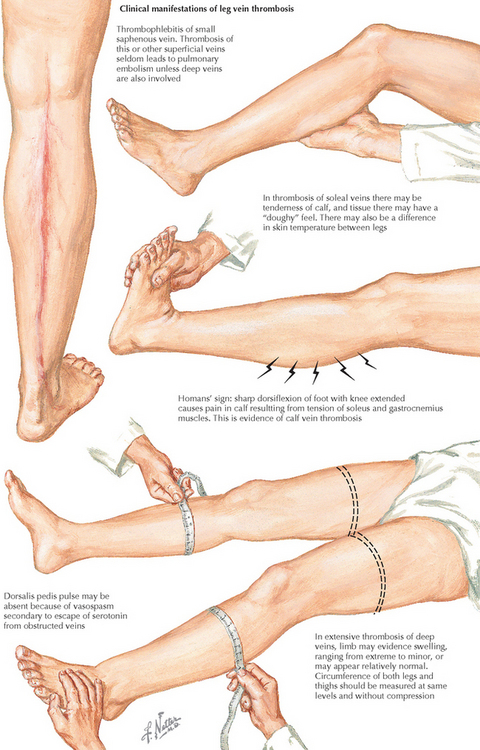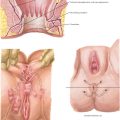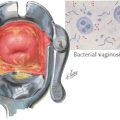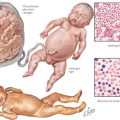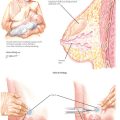Chapter 58 Thrombophlebitis
INTRODUCTION
ETIOLOGY AND PATHOGENESIS
DIAGNOSTIC APPROACH
Workup and Evaluation
MANAGEMENT AND THERAPY
Nonpharmacologic
Drug(s) of Choice
FOLLOW-UP
MISCELLANEOUS
Agnelli G, Piovella F, Buoncristiani P, et al. Enoxaparin plus compression stockings compared with compression stockings alone in the prevention of venous thromboembolism after elective neurosurgery. N Engl J Med. 1998;339:80.
Pinede L, Ninet J, Duhaut P, et alInvestigators of the “Duree Optimale du Traitement AntiVitamines K” (DOTAVK) Study. Comparison of 3 and 6 months of oral anticoagulant therapy after a first episode of proximal deep vein thrombosis or pulmonary embolism and comparison of 6 and 12 weeks of therapy after isolated calf deep vein thrombosis. Circulation. 2001;103:2453.
Prandoni P, Tormene D, Pesavento R, Vesalio Investigators Group. High vs. low doses of low-molecular-weight heparin for the treatment of superficial vein thrombosis of the legs: a double-blind, randomized trial. J Thromb Haemost. 2005;3:1152.
Scurr JH, Machin SJ, Bailey-King S, et al. Frequency and prevention of symptomless deep-vein thrombosis in long-haul flights: a randomised trial. Lancet. 2001;357:1485.
Superficial Thrombophlebitis Treated by Enoxaparin Study Group. A pilot randomized double-blind comparison of a low-molecular-weight heparin, a nonsteroidal anti-inflammatory agent, and placebo in the treatment of superficial vein thrombosis. Arch Intern Med. 2003;163:1657.
Anonymous. Low-molecular-weight heparin in the treatment of patients with venous thromboembolism. The Columbus Investigators. N Engl J Med. 1997;337:657.
Anonymous. Prevention of pulmonary embolism and deep vein thrombosis with low dose aspirin: Pulmonary Embolism Prevention (PEP) trial. Lancet. 2000;355:1295.
Daniel KR, Jackson RE, Kline JA. Utility of lower extremity venous ultrasound scanning in the diagnosis and exclusion of pulmonary embolism in outpatients. Ann Emerg Med. 2000;35:547.
Grady D, Sawaya G. Postmenopausal hormone therapy increases risk of deep vein thrombosis and pulmonary embolism. Am J Med. 1998;105:41.
Joffe HV, Kucher N, Tapson VF, Goldhaber SZ, Deep Vein Thrombosis (DVT) FREE Steering Committee. Upper-extremity deep vein thrombosis: a prospective registry of 592 patients. Circulation. 2004;110:1605. Epub 2004 Sep 7
Kamran SI, Downey D, Ruff RL. Pneumatic sequential compression reduces the risk of deep vein thrombosis in stroke patients. Neurology. 1998;50:1683-1688.
Lepercq J, Conard J, Borel-Derlon A, et al. Venous thromboembolism during pregnancy: a retrospective study of enoxaparin safety in 624 pregnancies. BJOG. 2001;108:1134.
Lutter KS, Kerr TM, Roedersheimer LR. Superficial thrombophlebitis diagnosed by duplex scanning. Surgery. 1991;110:42.
Tagalakis V, Kahn SR, Libman M, Blostein M. The epidemiology of peripheral vein infusion thrombophlebitis: a critical review. Am J Med. 2002;113:146.
American College of Obstetricians and Gynecologists. Thromboembolism in pregnancy. ACOG Practice Bulletin 19. Washington, DC: ACOG, 2000.
American College of Obstetricians and Gynecologists. Prevention of deep vein thrombosis and pulmonary embolism. ACOG Practice Bulletin 20. Washington, DC: ACOG, 2000.
American College of Obstetricians and Gynecologists. Air travel during pregnancy. ACOG Committee Opinion 261. Washington, DC: ACOG, 2001.
American College of Obstetricians and Gynecologists. Safety of Lovenox in pregnancy. ACOG Committee Opinion 276. Washington, DC: ACOG, 2002.
Katz VL. Postoperative counseling and management. In: Katz VL, Lentz GM, Lobo RA, Gershenson DM, editors. Comprehensive Gynecology. 5th ed. Philadelphia: Mosby/Elsevier; 2007:672.
Samlaskie CP, James WD. Superficial thrombophlebitis. I. Primary hypercoagulable states. J Am Acad Dermatol. 1990;22:975.
Samlaskie CP, James WD. Superficial thrombophlebitis. II. Secondary hypercoagulable states. J Am Acad Dermatol. 1990;23:1.
Vandenbroucke JP, Helmerhorst FM, Bloemenkamp KW, Rosendaal FR. Third-generation oral contraceptive and deep venous thrombosis: from epidemiologic controversy to new insight in coagulation. Am J Obstet Gynecol. 1997;177:887.
Weinman EE, Salzman EW. Deep-vein thrombosis. N Engl J Med. 1994;331:1630.

